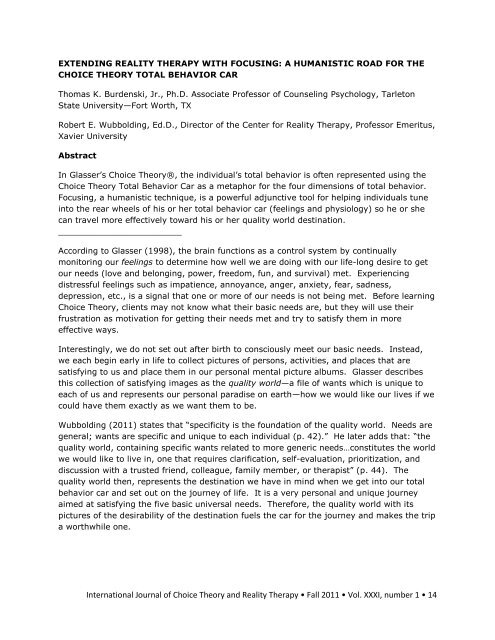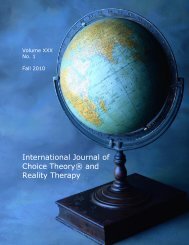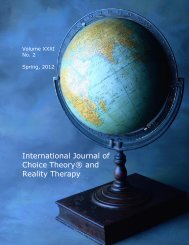International Journal of Choice Theory® and Reality ... - CTRTJournal
International Journal of Choice Theory® and Reality ... - CTRTJournal
International Journal of Choice Theory® and Reality ... - CTRTJournal
Create successful ePaper yourself
Turn your PDF publications into a flip-book with our unique Google optimized e-Paper software.
EXTENDING REALITY THERAPY WITH FOCUSING: A HUMANISTIC ROAD FOR THE<br />
CHOICE THEORY TOTAL BEHAVIOR CAR<br />
Thomas K. Burdenski, Jr., Ph.D. Associate Pr<strong>of</strong>essor <strong>of</strong> Counseling Psychology, Tarleton<br />
State University—Fort Worth, TX<br />
Robert E. Wubbolding, Ed.D., Director <strong>of</strong> the Center for <strong>Reality</strong> Therapy, Pr<strong>of</strong>essor Emeritus,<br />
Xavier University<br />
Abstract<br />
In Glasser‘s <strong>Choice</strong> <strong>Theory®</strong>, the individual‘s total behavior is <strong>of</strong>ten represented using the<br />
<strong>Choice</strong> Theory Total Behavior Car as a metaphor for the four dimensions <strong>of</strong> total behavior.<br />
Focusing, a humanistic technique, is a powerful adjunctive tool for helping individuals tune<br />
into the rear wheels <strong>of</strong> his or her total behavior car (feelings <strong>and</strong> physiology) so he or she<br />
can travel more effectively toward his or her quality world destination.<br />
________________________<br />
According to Glasser (1998), the brain functions as a control system by continually<br />
monitoring our feelings to determine how well we are doing with our life-long desire to get<br />
our needs (love <strong>and</strong> belonging, power, freedom, fun, <strong>and</strong> survival) met. Experiencing<br />
distressful feelings such as impatience, annoyance, anger, anxiety, fear, sadness,<br />
depression, etc., is a signal that one or more <strong>of</strong> our needs is not being met. Before learning<br />
<strong>Choice</strong> Theory, clients may not know what their basic needs are, but they will use their<br />
frustration as motivation for getting their needs met <strong>and</strong> try to satisfy them in more<br />
effective ways.<br />
Interestingly, we do not set out after birth to consciously meet our basic needs. Instead,<br />
we each begin early in life to collect pictures <strong>of</strong> persons, activities, <strong>and</strong> places that are<br />
satisfying to us <strong>and</strong> place them in our personal mental picture albums. Glasser describes<br />
this collection <strong>of</strong> satisfying images as the quality world—a file <strong>of</strong> wants which is unique to<br />
each <strong>of</strong> us <strong>and</strong> represents our personal paradise on earth—how we would like our lives if we<br />
could have them exactly as we want them to be.<br />
Wubbolding (2011) states that ―specificity is the foundation <strong>of</strong> the quality world. Needs are<br />
general; wants are specific <strong>and</strong> unique to each individual (p. 42).‖ He later adds that: ―the<br />
quality world, containing specific wants related to more generic needs…constitutes the world<br />
we would like to live in, one that requires clarification, self-evaluation, prioritization, <strong>and</strong><br />
discussion with a trusted friend, colleague, family member, or therapist‖ (p. 44). The<br />
quality world then, represents the destination we have in mind when we get into our total<br />
behavior car <strong>and</strong> set out on the journey <strong>of</strong> life. It is a very personal <strong>and</strong> unique journey<br />
aimed at satisfying the five basic universal needs. Therefore, the quality world with its<br />
pictures <strong>of</strong> the desirability <strong>of</strong> the destination fuels the car for the journey <strong>and</strong> makes the trip<br />
a worthwhile one.<br />
<strong>International</strong> <strong>Journal</strong> <strong>of</strong> <strong>Choice</strong> Theory <strong>and</strong> <strong>Reality</strong> Therapy • Fall 2011 • Vol. XXXI, number 1 • 14




